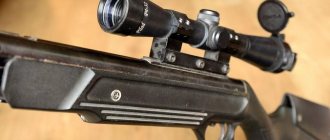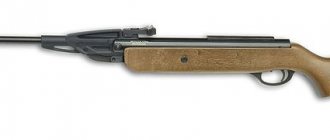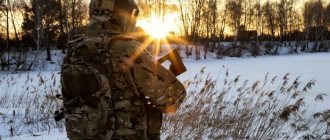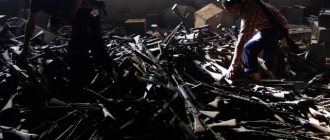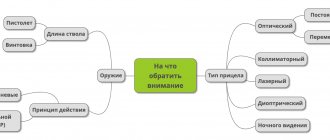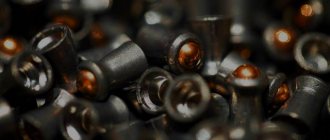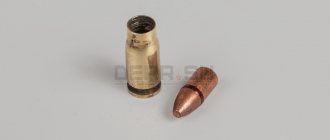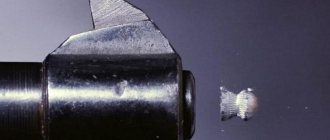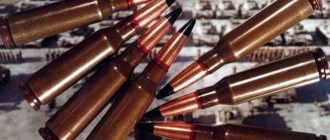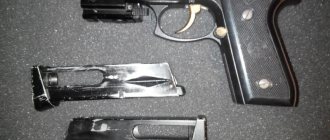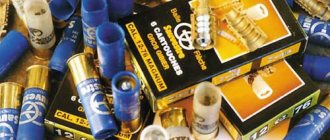The choice of airgun ammunition is a point that rarely gets the attention it deserves. But in vain! After all, the accuracy and result of shooting, the service life and successful operation of the weapon, and in general, let’s not be afraid of this word, your personal safety directly depend on them. Therefore, today we are learning how to choose the right balls and understand the whole variety of assortments on the market.
Balls used for pneumatic shooting are also called explosive shot. They appeared on the market recently - when weapons powered by carbon dioxide appeared with installed bunker-type stores. The advantage of this type of projectile is its rounded shape: the balls are easy to install in the magazine. In addition, a bunker-type magazine does not require a neat ball-to-ball arrangement - they usually use a magnetic system for feeding projectiles, and this rule works for both pneumatic and airsoft weapons. The only difference is that pneumatic guns use metal projectiles, while airsoft guns use plastic balls.
Material
The first criterion that is worth paying attention to is the material from which the pneumatic shooting balls are made. For pneumatic weapons with a caliber of 4 to 9 mm, metal projectiles are used. Conventionally, metal ammunition is divided into two groups:
- Lead;
- Steel.
To protect against corrosion, the steel ball can be coated with copper, zinc, nickel or brass. For lead, no additional coating is required. Brass and nickel are rarely used due to their lack of ductility, so let's take a closer look at copper and zinc.
Copper cartridges usually have a yellow or reddish-yellow tint. The advantages of such a coating are its high ductility. Also, such shells do not damage the barrel rail, which extends the life of the weapon. But it is more expensive when compared with zinc.
Zinc balls can be stored longer: this metal perfectly protects the core from moisture. The disadvantage of such ammunition is the lower ductility of the coating compared to copper, so it is better to use them exclusively in smooth-bore weapons with a brass rail.
Weight
The weight of balls made from different materials varies slightly. Copper-plated and galvanized steel balls weigh approximately the same. Explosive shot, designed specifically for CO2 pistols, is the lightest, its weight can reach 0.33 g (depending on the core material). The heaviest are lead shells: their weight is up to 0.51 g, but the shape and size of the ball plays an important role here.
It is also worth considering that the weight of the balls may vary even within the same package: during the process of running in the projectiles, the production technology may be slightly disrupted. So sometimes some balls have different diameters and flaws in the form of sagging. We recommend choosing consumables from trusted manufacturers so that this difference is minimal.
The slight difference in ammunition weight is not critical, since air guns are often used solely for recreational shooting.
General information about airsoft balls
Airsoft balls are used as ammunition, are made of plastic and have a diameter of 6 millimeters.
The range of airsoft balls is huge and there are a number of features when choosing them. In this article we will help you understand the intricacies of choosing airsoft balls.
No matter what type or model of airsoft drive you use, the balls will be the same size, namely 6mm in diameter.
However, airsoft balls differ in other ways. Here they are:
- weight;
- view;
- company manufacturer.
Caliber
Air gun projectiles come in several possible calibers. The most common is 4.5 mm, which is sometimes also classified as BB. In general, the name of explosives in the American classification is associated with balls with a caliber of 0.18 inches, or, in terms of the metric system, 4.57 mm. In addition, there are copper-plated or galvanized balls with a diameter of 4.35 and 4.44, also belonging to the explosive class.
In general, all air guns can be divided into:
- Small-caliber (4 - 4.5 mm);
- Medium-caliber (5.5 - 6 mm);
- Large-caliber (7.62 - 9 mm).
Depending on this criterion, suitable projectiles are selected.
What are the best air rifle bullets on the market?
The huge variety of air guns has led to the emergence of an even larger number of bullets, which can have different shapes, compositions, weights, prices and purposes.
In many countries around the world, hunting with air rifles is allowed, so the popularity of such weapons is constantly growing. There are even models of pneumatic weapons that are superior in combat performance to smoothbore hunting rifles.
Some bullets may be the best for one rifle, but for another they turn out to be useless in terms of combat qualities. This is due to many characteristics not only of the bullet itself, but also of the air gun.
Recommended bullets for 4.5 mm caliber:
- bullets production;
- bullets production;
- bullets (there are many fakes);
- “GAMO” bullets (can be used as a budget option);
- "DIABOLO" bullets.
Each company has its own types of bullets with specific characteristics. If everything is clear with the general preference, then there are still questions with the choice of a specific bullet model from a particular company.
Which balls are better?
When choosing balls, be sure to consider the characteristics of your weapon. In general, steel ammunition coated with copper or zinc is used for smooth-bore weapons with hopper magazines, and lead balls are used for rifled barrels.
Why is this so? The fact is that for weapon models with a rifled barrel, it is usually made of steel. If a steel ball passes through it, then despite the layer of soft metal with which it is covered, such a ball will not be able to fit tightly into the rifling. Lead balls do an excellent job of this task, but in a smoothbore weapon such heavy projectiles will require force to fire, which will lead to premature wear.
To summarize: if your weapon is smoothbore and has a hopper magazine, give preference to zinc or copper coated balls. If you use a rifled rifle or pistol for shooting, then it would be best to purchase spherical bullets made of lead.
The best balls for pneumatic guns according to Steel-gun.ru
We have studied the entire range of balls presented in our online store and tried to select consumables suitable for most types of air guns. They are made of high quality metal, smooth and glide well without having a negative impact on the insides of the pneumatic.
Shot BB Gletcher 500 pcs
Buy shot BB Gletcher 500 pcs
Neat, smooth balls from Gletcher, made of galvanized steel, are an ideal choice for those who care about the safety of their airsoft weapons and maintaining their performance for years to come. After all, low-quality consumables (with an uneven surface, different sizes) can damage the weapon and put it out of action ahead of time. The small package contains 500 pieces and has a convenient dispenser. Thanks to this dispenser, you can quickly charge your weapon and continue to enjoy shooting. The caliber of the balls is 4.5 mm and they are perfect for all types of air guns.
Black pneumatic balls STALKER BLACK (caliber 4.5 mm, 250 pcs/can)
Buy black pneumatic balls STALKER BLACK (caliber 4.5 mm, 250 pcs/can)
Black pneumatic balls STALKER BLACK (4.5 mm, 250 pcs/can) - used for shooting air guns with a smooth barrel. Made of high quality durable steel, have a smooth black finish. The ball surface is smooth, which reduces friction in the barrel. Used for target shooting. The country of origin is Taiwan.
Copper-coated STALKER pneumatic balls (500 pcs/can, diameter 4.5 mm)
Buy copper-plated STALKER pneumatic balls (500 pcs/can, diameter 4.5 mm)
Stalker copper-plated balls 4.5 mm 500 pcs. Designed for recreational and training shooting from smooth-bore pneumatic weapons. Coated with a thin layer of copper to reduce friction and prevent corrosion. The surface of the ball is perfectly round, polished, without potholes or dents. It glides comfortably along the barrel of the weapon without catching or damaging it.
Shot BB Gletcher 1000pcs
Buy shot BB Gletcher 1000pcs
Despite the fact that shot is a consumable material, it cannot be allowed to be of poor quality. Rough, uneven projectiles can damage the weapon or render it completely inoperable. Therefore, we recommend you BB Gletcher shot - perfectly smooth balls of the same size glide perfectly and are designed specifically for pneumatics with a caliber of 4.5 mm. The large volume of the can guarantees that consumables will not run out at the most inopportune moment. A functional cap with a thin spout allows you to comfortably load the weapon without losing a single ball.
Copper-plated ball “BORNER-Premium” BLISTER (250 pcs)
Buy copper-plated ball “BORNER-Premium” BLISTER (250 pcs)
Copper-plated balls “BORNER-Premium” in blister packaging in the amount of 250 pieces. The base of the ball is steel, coated on the outside with copper. The round shape and the absence of roughness on the surface help to hit the target at a considerable distance. The ball has the necessary mass for its size, which gives it flight stability when shooting. Used to fire air guns designed to use a ball in the form of a bullet.
Galvanized balls “BORNER-Premium” BANK (250 pcs)
Buy galvanized balls “BORNER-Premium” BANK (250 pcs)
Galvanized balls “BORNER-Premium” are produced for air weapons: rifles, machine guns, pistols and shotguns; in addition, bullets are used in airsoft grenades. The round shape of the balls was chosen for a reason; it is this shape that ensures minimal friction with the air and maximum flight speed. The Chinese manufacturer guarantees a minimum amount of defects in one package.
Be sure to choose shells from trusted manufacturers - in this case, the chance that you will encounter critical defects is minimal. Our online store presents balls from well-known companies - Gamo, Gletcher, Borner, Gunter and others, which have proven themselves on the market and are suitable for most types of airsoft and pneumatic weapons.
Balls "Golden Bullet" for air guns
4.5 mm ammunition is used to fire air guns. When shooting from rifled pneumatics, lead bullets of various shapes and weights are used. However, among air guns there are many models with a smooth barrel. There are especially many options for smooth-bore pneumatics in the range of pistols. Although there are examples of rifles and machine guns that fire steel spherical bullets.
Some models of pistols and rifles are also produced that use both types of ammunition - lead bullets and steel balls. These models usually have a rifled barrel and two types of magazines for different charges.
The so-called “ball launchers” have become widespread due to the ease of designing magazines for spherical bullets, and the possibility of fixing the ball using a magnet. For this type of air gun, special ammunition is produced - steel explosive balls, or they are called spherical bullets of 4.5 mm caliber.
The assortment of pneumatic stores includes balls of domestic and imported production. Spherical bullets come in uncoated steel, galvanized balls, and copper-plated spherical bullets.
Let's look at the Golden Bullet balls produced by NPF Relax. These spherical bullets are available in 4 types of packaging. In a jar of 1500 pcs., in a jar of 500 pcs., in a bottle of 250 pcs. and in a bag containing 200 pcs. balls.
Balls in a capacious package of 1500 pieces can be purchased when a good supply of bullets is required. From a capacious jar, you can pour the required amount into smaller containers when you plan to go shooting. You can also take a large jar of balls if you plan to shoot with a whole group. For example, as additional entertainment at a picnic. With such packaging, you don’t have to worry about unexpectedly running out of ammunition.
Also, large packaging is more economical when purchasing. For any product it is known that the larger the packaging, the lower the cost. In the case of spherical bullets, the situation is similar. By purchasing a capacious package of “golden bullet” balls, each ball is cheaper and the cost of the shot is reduced.
The smallest package contains 200 pcs. spherical bullets. The balls are packed in a plastic bag. It's small enough and relatively light that you can put it in your pocket. Typically, when shooting a pistol, one cylinder is enough for 60 shots, so a bag of 200 balls is enough for three cylinders. This is quite enough to shoot for fun. In addition, this type of packaging has a low price.
The average package contains 500 golden bullet balls. This is the most common packaging because it has the optimal size and number of balls. It can be placed in a jacket pocket or in a special bag along with a pistol.
Packaging of 250 pcs is also available. Balls of 250 pieces are packed in special bottles. photo 250 pcs.
Golden bullet balls have a high surface cleanliness. In addition, these spherical bullets are coated with a copper layer. Copper-plated balls, compared to uncoated steel balls, have better ballistic and anti-corrosion properties. They have a lower coefficient of friction and copper is much softer than steel, so copper-plated balls glide better and wear out the barrel less.
Copper coating is the most optimal for a spherical bullet. Uncoated balls tend to rust, so over time they contaminate the barrel and contribute to its corrosion. The coating sometimes peels off from galvanized balls. In addition, zinc oxidation products are harder than metal and scratch the barrel, as well as wear out the plastic parts of the magazines. Copper coating does not oxidize and is much softer than other metals.
The production of spherical golden bullet bullets uses technology that was only available to the defense industry just a few years ago. Therefore, the golden bullet balls have a very high-quality coating, which even externally has a golden tint, which is why the balls received the name “golden bullet”.
Let's do some tests on the copper-plated "golden bullet" balls. At the same time, for testing, a package of copper-plated balls from another manufacturer was opened. The following photo shows balls from two manufacturers. It may not be very noticeable in the photo, but the “golden bullet” balls located on the right are lighter and more golden, perhaps because they have greater resistance to oxidation.
For the purity of the experiment, let’s open all four types of packaging with “golden bullet” balls and mix some of the balls. Since it is possible that the bullets were fired at different times, let's check whether the workmanship varies from batch to batch. From the total pile we will select approximately 30 bullets for the first testing.
As you know, explosive balls are intended for pneumatics of 4.5 mm caliber. This is the caliber of the airgun barrel itself. Two types of ammunition are used for pneumatics of this caliber. Lead bullets have a slightly larger diameter, in the range of 4.6-4.7 mm, to contact the barrel rifling and produce spin. The steel balls have a diameter of 4.4 mm, and when fired they are not in constant contact with the barrel, that is, they are so-called “sub-caliber” ammunition.
First, we will measure the diameters of the balls to check whether there are bullets that clearly do not correspond to the diameter. To prevent balls that are too large from entering the weapon’s magazine and could jam the barrel or magazine. Or, conversely, check for bullets with a clearly smaller diameter, which may affect the overall shooting result.
Having taken the time to measure three dozen balls, we note that the spread of bullet diameters is 4.36 – 4.38 mm. Moreover, approximately 80% of the balls have a value of 4.37 mm. This means both consistent workmanship of the steel ball itself and uniformity of the copper coating. Thus, when loading a clip with golden bullet balls, you can be sure that all the balls have the same characteristics. This can also guarantee stable accuracy results, of course, subject to the accuracy of the shooter himself.
We also check the shape of the balls by measuring the diameter of the bullet in different positions. The device shows the same numbers. If the ball has a diameter of 4.38 mm, then it shows this value at different transverse dimensions, which indicates that the bullet is of the correct spherical shape.
Let's also try to measure the weight of the balls. There were no precise scales at hand that would allow us to measure tenths of a gram, so we use household scales, but with a fairly wide measurement scale. Let's count out 150 balls and pour them into the scales. They show exactly 50 grams. It turns out that one ball weighs 0.33 grams. For comparison, we weigh copper-plated balls from another manufacturer - the scales show approximately 46 grams, that is, one ball weighs 0.3 grams.
The “golden bullet” balls are a little heavier, and when shooting, this should have a good effect on a more stable flight of the bullet and high penetration ability. Therefore, they are good to use, for example, for punching cans and breaking bottles. Which, in principle, is what is required from balls, since for accurate shooting at targets it is better to use rifled pneumatics and lead bullets.
The next test is to measure the time it takes for the balls to pass through a 4.5mm barrel. The barrel extension for the Drozd air rifle is used as a test barrel. The tests used golden bullet pellets and spherical bullets from two other manufacturers.
We place the barrel vertically and lower the balls one by one. When releasing the ball, close the inlet hole of the barrel and note the time of passage of the ball. The ball transit time characterizes the quality of the balls, that is, their sphericity and manufacturing accuracy, which ultimately affects the ballistic characteristics.
The following table shows the results of comparative tests.
Ball brand: Ball transit time, (sec)
"Golden Bullet" 2.09 2.34 2.2 2.28 2.43 2.92
Manufacturer 1 3.17 5.79 stuck 1.97 5.79
Manufacturer 2 6.28 0.93 4.97 stuck 1.08
As can be seen from the comparison, the “golden bullet” balls show the most stable results. This means that these spherical bullets will show better accuracy when fired.
One manufacturer's bullets take significantly longer to pass through the test barrel. This means that the bullets have a larger diameter. On the one hand, they will receive more energy when fired, but there is a danger of the ball getting stuck in the barrel or magazine of the weapon, which, by the way, is what the test shows.
Some pellets from other brands go through the barrel much faster and will not get stuck in the barrel. However, this means a much smaller ball diameter. They will let some of the air through the barrel and have a lower initial velocity. In addition, they have a strong spread in travel time, and this will lead to unstable accuracy results.
The “golden bullet” balls have an optimal diameter; accordingly, a fairly optimal air gap is formed in the barrel around the ball, which, on the one hand, allows you to save the barrel from wear, and on the other, makes the most of the energy of the air pulse.
Next we carry out ballistic tests. First of all, let's try to shoot at cans. The material was prepared in the cold season, so test shooting was carried out indoors, using a bullet catcher.
The balls were loaded into the magazine of a relatively powerful Crosman C31 pistol. The shooting was carried out from a distance of approximately 6 meters. Simultaneously with shooting at a tin can, shooting was carried out at targets from each clip.
Of course, from the first stores the balls easily penetrate a tin can. Of course, a lot depends on the pistol, but here we can state that the bullets serve their purpose and are no worse than other options. The penetration ability decreased only after the 4th magazine, and the balls began to leave only deep dents.
Let's also note target shooting. Here, of course, the sensations are purely subjective and much depends on the type of pneumatic and the accuracy of the shooter himself. Since the author of this material has some experience in shooting from air guns, the results of shooting, especially from a short distance, can be seen in the next photo.
Therefore, we can conclude that the “golden bullet” balls have decent ballistic properties and good accuracy, that is, they fly exactly where the shooter is aiming.
We noted that the golden bullet balls are a little heavier than other similar balls. Accordingly, they must have a large reserve of energy and good penetration ability. Target shooting was carried out using a homemade bullet catcher, with several layers of different materials - cardboard, polyethylene, foam rubber. At the base of the bullet catcher there is a sheet of stainless steel.
After the shooting, we open the bullet catcher and see that the bullets have penetrated all the materials, which partially damped the speed of the balls. Almost all the balls are located at the very base - on the steel sheet, and only the last balls, which have a lower initial speed, are stuck in soft materials.
You can see the dents the bullets left on the metal sheet, which once again confirms the good penetration ability. On the other hand, the balls themselves were also deformed.
This indicates the relative plasticity of the balls. Because balls that are too hard can have significant ricochet. The photograph also shows that despite the deformation, the copper plating was not damaged at all, and the steel base was not visible behind the copper coating. Which indicates the high quality of the copper coating.
For comparison, balls from other manufacturers were considered. In order not to create anti-advertising, we will not name the brand of ammunition, since much may depend on the batch, and even more so, manufacturers are working to improve the quality of their products. However, it can be noted that some samples even have an unattractive appearance.
Firstly, “golden bullet” balls clearly outperform uncoated steel balls and galvanized balls, since we have already outlined the advantages of copper coating. We also came across balls with a peeling white coating, which look very unpresentable, and probably have worse ballistic properties and are susceptible to corrosion. Even with copper-plated balls, upon closer examination, one could see small potholes that were not hidden even under the copper coating.
In other samples that passed external quality testing, one could find such shortcomings as a large spread in the diameters of the balls, which negatively affects the accuracy of fire. Or there was a scatter in the diameter of the ball in different cross sections, which indicates a non-ideal spherical shape. After shooting, examining the deformed balls of some manufacturers, one could see through the copper the steel base of the ball, which indicates poor-quality copper plating.
In general, it can be noted that the “golden bullet” balls correspond to the characteristics that apply to steel spherical bullets. And according to some indicators, both practically and subjectively, they exceed the characteristics of more expensive foreign ammunition.
Therefore, using copper-plated “golden bullet” balls, you can be confident both in the ballistic characteristics and in the reliable operation and safety of the air gun itself.
